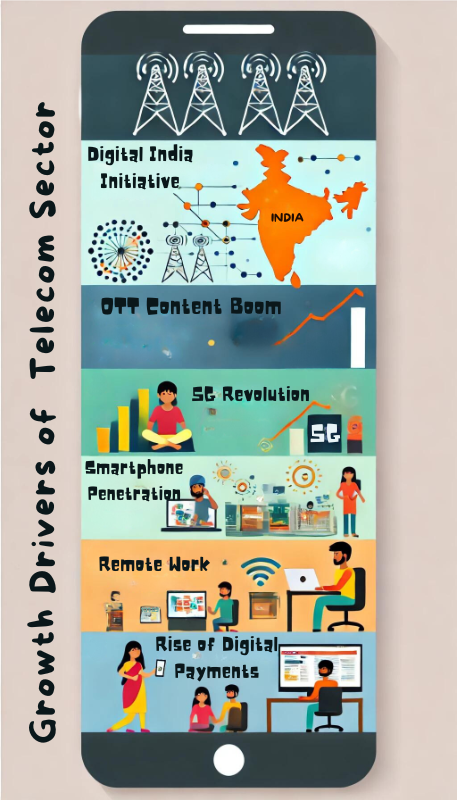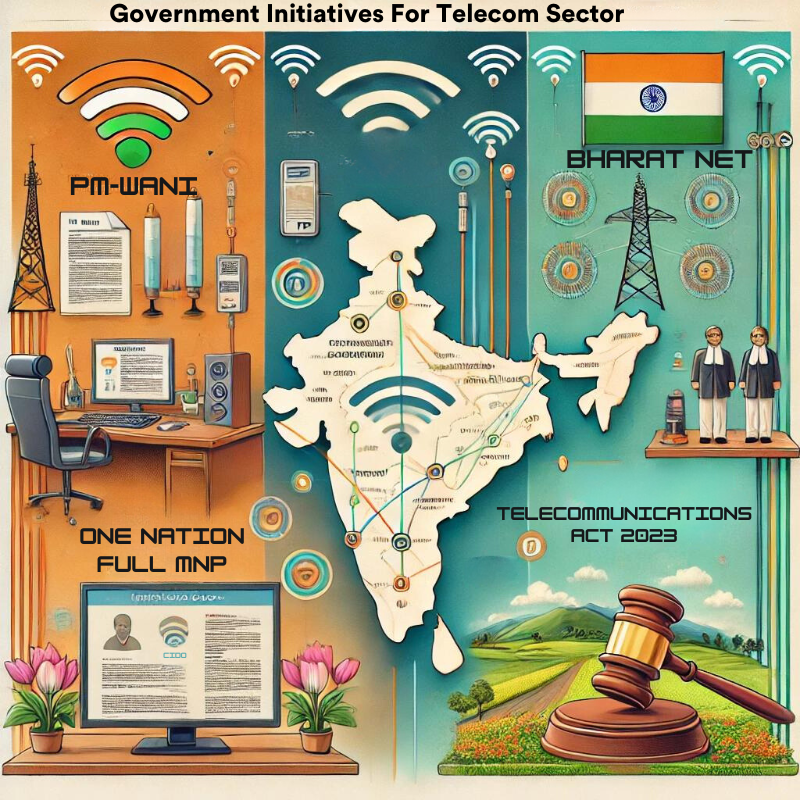The Indian telecom sector today stands at an important juncture, balancing the network infrastructure cost with the rapid growth of data traffic. The latter is majorly driven by Large Technology Giants whose services span a large requirement of network bandwidth. The sector feels that while these LTGs draw gigantic revenues from various serv ices used by Indians, their contribution to the underlying structure through which they offer those services remains almost negligible.
TSPs have been arguing that there needs to be a fair-share mechanism whereby LTGs would pay for network costs in some kind of proportion to data usage. Indeed, the subject has been debated worldwide, and South Korea has seen settlements between content providers and network operators; similarly, the US intends to consider legislation on similar lines. In India, too, such significant reforms are called for if it wants to ensure affordable digital connectivity for all in the telecom sector. That is, a balance wherein the reforms work to make the ecosystem fair, with all players, including LTGs paying a decent contribution to enhance the growth and sustainability of the digital infrastructure for the economy at large and for the common Indian.
| GS Paper | General Studies III |
| Topics for UPSC Prelims | India’s telecom sector, Telecom Service Providers, Digital India program, BharatNet, Unified Payments Interface, Adjusted Gross Revenue, OTT platforms, 5G Spectrum Auction, Prime Minister Wi-Fi Access Network Interface (PM-WANI), Bharat Net Project, One Nation Full Mobile Number Portability |
| Topics for UPSC Mains | Major Growth Drivers of the Telecom Sector in India, Major Challenges Related to the Telecom Sector in India. |
Origin of the Article
This editorial is based on “Telecom sector must get a fair share” which was published in Financial Express on 07/09/2024. The article highlights the debate over fair-share contributions from large traffic-generating platforms (LTGs) to telecom service providers (TSPs). It argues that LTGs, despite profiting from telecom infrastructure, should contribute to network costs to ensure affordable and sustainable digital connectivity.
Relevance for UPSC Students
Understanding this topic is crucial for UPSC aspirants as it relates directly to India’s digital economy, government policies, and infrastructure development. It aligns with GS Paper 2 and GS Paper 3 of the UPSC syllabus, providing insights into industrial growth, government policies, and economic interventions. This knowledge aids in comprehensively understanding the dynamics and challenges of India’s telecom sector.
Why in News
The debate over fair-share contributions from Large Traffic-Generating platforms (LTGs) to Telecom Service Providers (TSPs) is crucial for UPSC aspirants as it touches upon several key topics like government policies, digital infrastructure, and economic sustainability. This issue relates to previous UPSC questions on digital initiatives and infrastructure, making it highly relevant for understanding the evolving dynamics of India’s telecom sector and its broader economic implications.
Major Growth Drivers of the Telecom Sector in India
While this has marinated the Indian telecom sector into exponential growth, particularly owing to a slew of major factors, it has been driven fundamentally by several key drivers: Digital India Initiative, affordable smartphone penetration, the rollout of 5G services, increase in digital payments, the boom in OTT content surge, along with remote work and education. All these drivers have worked colossally together to shape the new digital terrain of India, making connectivity wider and closer to everyday living.
Digital India Initiative
Digital India, started in the year 2015, has accelerated the growth in the telecommunication industry. The plan has demanded Internet services both in the rural and urban areas. Plans such as BharatNet, for instance, need to connect 250,000-gram panchayats with broadband, thereby improving rural connectivity, which in turn drives the expansion of telecom into the country’s interiors.
Affordable Smartphone Penetration
The easy availability of budget smartphones has given a serious fillip to the growth. India shipped 146 million smartphones this year, with affordability drives like Google’s Android One program and local manufacturing drives making budget phones widely available in tier 2 and tier 3 cities, thereby increasing the subscribers of telecom services.
5G Revolution
The rollout of 5G services in India, which began in October 2022, has been a game-changer. By December 2023, 5G technology had reached 738 districts and around 100 million users. This technology is expected to enable new use cases in IoT, smart cities, and industrial automation, creating new revenue streams for telecom companies.
Rise of Digital Payments
The surge in digital payments, driven by the Unified Payments Interface (UPI), has become a key driver for telecom growth. UPI transactions grew from 92 crore in FY 2017-18 to 8,375 crore in FY 2022-23. This shift towards digital transactions has increased dependency on mobile internet, driving data consumption and creating new revenue streams for telecom companies.
Over-the-Top (OTT) Content Boom
The explosive growth of OTT platforms has significantly boosted data consumption in India. The Indian OTT streaming industry is expected to grow to USD 13–15 billion over the next decade. High-bandwidth activities like video streaming have surged, with platforms like Hotstar reporting 50.5 crore views during IPL 2023. Telecom operators have responded by offering bundled services with OTT subscriptions, driving customer acquisition and data usage.
Remote Work and Education
The Covid-19 pandemic accelerated the adoption of remote work and online education, leading to increased data consumption. Telecom companies upgraded network capacities and offered specialized work-from-home plans to meet this demand. The trend has persisted post-pandemic, with hybrid work models ensuring sustained high demand for reliable, high-speed internet connectivity.

Major Challenges Related to the Telecom Sector in India
Despite the significant growth, the telecom sector in India faces several challenges. Financial stress, the AGR dispute, infrastructure gaps, high spectrum pricing, quality of service issues, cybersecurity threats, and regulatory challenges are major hurdles. Addressing these issues is crucial for sustainable growth and quality service delivery in the telecom sector.
Financial Stress
The telecom industry is burdened with high spectrum costs, intense competition leading to tariff wars, and substantial infrastructure investments. As of March 2023, the industry’s total debt stood at approximately Rs 6.4 lakh crore. Vodafone Idea, for instance, owes Rs 2.1 lakh crore. This financial stress has led to reduced capital expenditure and delayed 5G rollouts.
Adjusted Gross Revenue (AGR) Dispute
The AGR issue has been a persistent problem for Indian telecom operators. The Supreme Court’s 2019 ruling broadened the definition of AGR to include non-telecom revenues, resulting in a cumulative liability of Rs 1.69 lakh crore. Airtel, for example, has dues amounting to Rs 43,980 crore. This ongoing financial burden hampers the sector’s ability to invest in new technologies and infrastructure.
Infrastructure Gaps
Despite significant progress, India’s telecom infrastructure still faces a substantial urban-rural divide. As of March 2023, urban teledensity stood at 133.81%, while rural teledensity was only 57.71%. Challenges in rural areas include difficult terrain, inconsistent power supply, and lower return on investment, making infrastructure development challenging.
Spectrum Pricing
High spectrum prices have been a significant hurdle for Indian telecom operators. The 2022 5G spectrum auction raised Rs 1.5 lakh crore for the government, but operators argue that these high costs impede network expansion and quality improvement. India’s spectrum prices are among the highest globally, affecting the financial health of telecom companies and potentially slowing down the adoption of new technologies.
Quality of Service
Despite improvements, quality of service remains a persistent issue in India’s telecom sector. TRAI data shows that major operators failed to meet benchmarks in areas like call drop rates and connection success rates in several circles. Poor service quality leads to customer dissatisfaction and churn, impacting operator revenues.
Cybersecurity Threats
As India’s digital footprint expands, cybersecurity has become a critical concern. In 2022, India witnessed over 13.91 lakh cybersecurity incidents. Telecom networks, being the backbone of digital infrastructure, are prime targets. The introduction of 5G technology expands the attack surface, leading to financial losses and eroding customer trust.
Regulatory Challenges
The telecom sector grapples with a complex and sometimes unpredictable regulatory environment. Issues like frequent policy changes and multiple levies create operational uncertainties. The long-pending issue of defining OTT services and their regulation remains unresolved, affecting long-term planning and investment decisions in the sector.
Major Government Initiatives Related to the Telecom Sector
The government has launched several initiatives aimed at promoting the telecom sector. These initiatives focus on improving infrastructure, enhancing connectivity, and ensuring regulatory efficiency, thereby fostering growth and development in the sector.

Prime Minister Wi-Fi Access Network Interface (PM-WANI)
The PM-WANI initiative aims to provide affordable internet access through public Wi-Fi hotspots. This initiative is expected to significantly boost internet penetration and make digital connectivity more accessible to the masses.
Bharat Net Project
The Bharat Net project aims to connect gram panchayats with broadband, thereby boosting rural internet penetration. This project is a crucial step towards bridging the urban-rural digital divide and ensuring that rural areas have access to reliable internet services.
One Nation Full Mobile Number Portability (MNP)
The One Nation Full MNP initiative aims to provide seamless mobile number portability across the country. This initiative will enhance customer convenience and ensure that users can retain their mobile numbers irrespective of their location within the country.
The Telecommunications Act 2023
The Telecommunications Act 2023 focuses on optimal spectrum utilization through sharing, trading, and flexible use. It also updates the criteria for appointing TRAI members, ensuring better governance and efficiency in the telecom sector. This act is expected to streamline regulatory processes and promote industry growth.
Measures to Revamp Telecom Sector in India
To address the challenges and drive growth in India’s telecom sector, several strategic reforms and innovative approaches are necessary. These measures should focus on rationalizing spectrum pricing, promoting infrastructure sharing, enhancing rural connectivity, fostering innovation, developing skills, implementing green practices, simplifying licensing, and supporting data localization.

Rationalizing Spectrum Pricing
A balanced spectrum pricing model, including revenue-sharing and extended payment periods, can alleviate the financial burden on telecom operators. This approach could free up capital for infrastructure investment and improve network expansion and quality.
Infrastructure Sharing Incentives
Stronger policy incentives for infrastructure sharing among telecom companies, including tax rebates and a centralized asset database, can accelerate the 5G rollout. Infrastructure sharing can reduce capital expenditure and facilitate easier collaboration, especially in semi-urban and rural areas.
Rural Connectivity Fund
Establishing a dedicated Rural Connectivity Fund with efficient utilization, focusing on public-private partnerships, can significantly improve rural infrastructure. Allocating a percentage of AGR from telcos for rural development can enhance connectivity in underserved areas.
Regulatory Sandbox for Innovation
A regulatory sandbox can allow telecom companies to test innovative services and business models with regulatory flexibility. Oversight from a committee comprising TRAI, DoT, and industry representatives can facilitate trials for emerging technologies, leading to new revenue streams and innovative solutions.
Skill Development Initiative
A comprehensive skill development program in collaboration with the telecom industry can address the talent gap. Partnerships with universities to introduce specialized courses in 5G, IoT, and AI can boost innovation and ensure a skilled workforce for the sector.
Green Telecom Policy
Implementing a Green Telecom Policy to promote sustainable practices, including renewable energy adoption and energy-efficient equipment, can reduce the carbon footprint. This approach can lead to significant environmental benefits and operational cost savings for telecom companies.
Simplified Licensing Regime
Streamlining the multi-license system into a unified license framework with an online single-window clearance system can reduce operational costs and attract more foreign investment. Simplified licensing can enhance regulatory efficiency and promote industry growth.
Data Localization Support
Developing a supportive framework for data localization, including tax incentives for local data centers and collaboration with the IT Ministry, can enhance data security. This initiative can create new revenue streams and ensure that data remains within national boundaries, boosting the telecom sector’s growth.
PESTEL Analysis
| Political: The industry is a quite complex regulatory ecosystem, wherein changes in policies with high levies affect operational dynamics. Initiatives such as the Bharat Net Project and the recent Telecommunications Act 2023 show that the government is geared toward infrastructure development and better governance. The LTG mechanism of fair share may turn into a policy priority to redistribute the financial burdens of the licenses. Economical: High industry debt—₹ 6.4 lakh crore—on account of spectrum costs and financial liabilities relating to AGR disputes continues to stress economic stability. In a positive light, growth drivers such as increasing digital payments and budget smartphones are creating market opportunities. The scale of the economics of 5G and various digital initiatives envisages great growth potential. Social: Increasing internet penetration across rural and urban geographies is changing consumer behavior, as reflected in the increasing digital payments and usage of the OTT platform. COVID-19 has permanently changed norms of remote work and education, hence making telecom services a necessity. Technological: The key drivers are the rollout of 5G and the increased use of IoT and smart technologies. However, cybersecurity is a serious concern, with over 13.91 lakh incidents reported in 2022, thus requiring sound security measures. Environmental: The Green Telecom Policy does indicate moving to green of the sector. This may relate to bringing down carbon footprints, ensuring energy-efficient technologies are used, etc. Legal: Legal challenges include the AGR dispute and high spectrum pricing. One would expect the new Telecommunications Act 2023 to heed this by being focused on better utilization and governance of spectrum. |
Conclusion
The Indian telecom industry is at an interesting juncture and requires far-reaching reforms to find solutions to financial problems, regulatory complexity, and infrastructure gaps. The full potential will be realized by rationalizing spectrum pricing, encouraging sharing of infrastructure, and promoting innovation via regulatory sandboxes. Initiatives like the Telecommunication Act 2023 by the government, along with environment-friendly practices and connectivity in rural areas, will ensure all-round sustainable growth.
| UPSC Civil Services Examination, Previous Year Questions (PYQs) Mains Q. How can the ‘Digital India’ programme help farmers to improve farm productivity and income? What steps has the government taken in this regard? (GS Paper III, 2015) Q. Examine the role of large technology giants (LTGs) in the digital economy. Should LTGs be made to contribute to the network infrastructure, as argued by telecom service providers (TSPs)? Discuss the global precedents and challenges involved in such a policy shift in India. |

